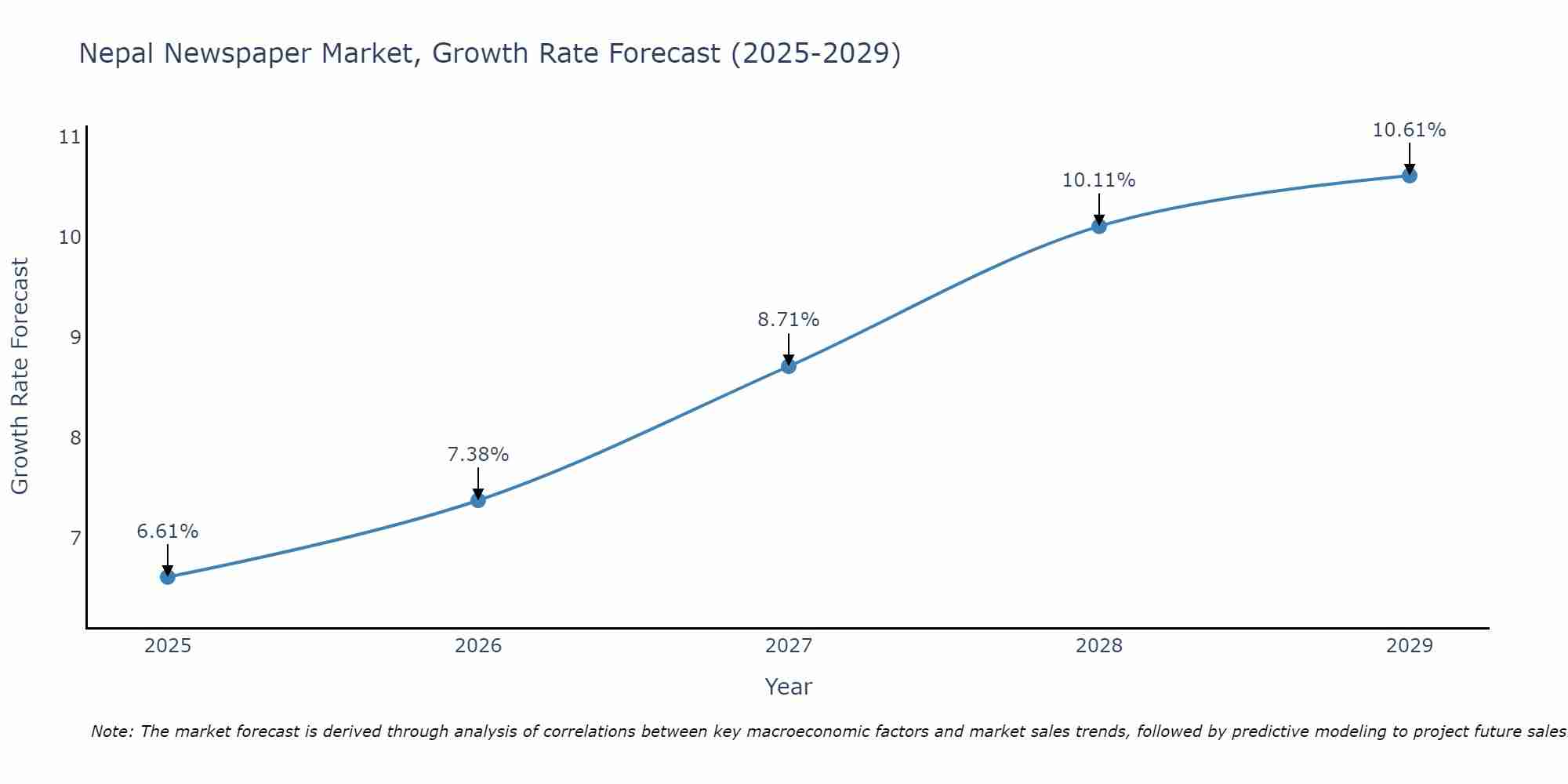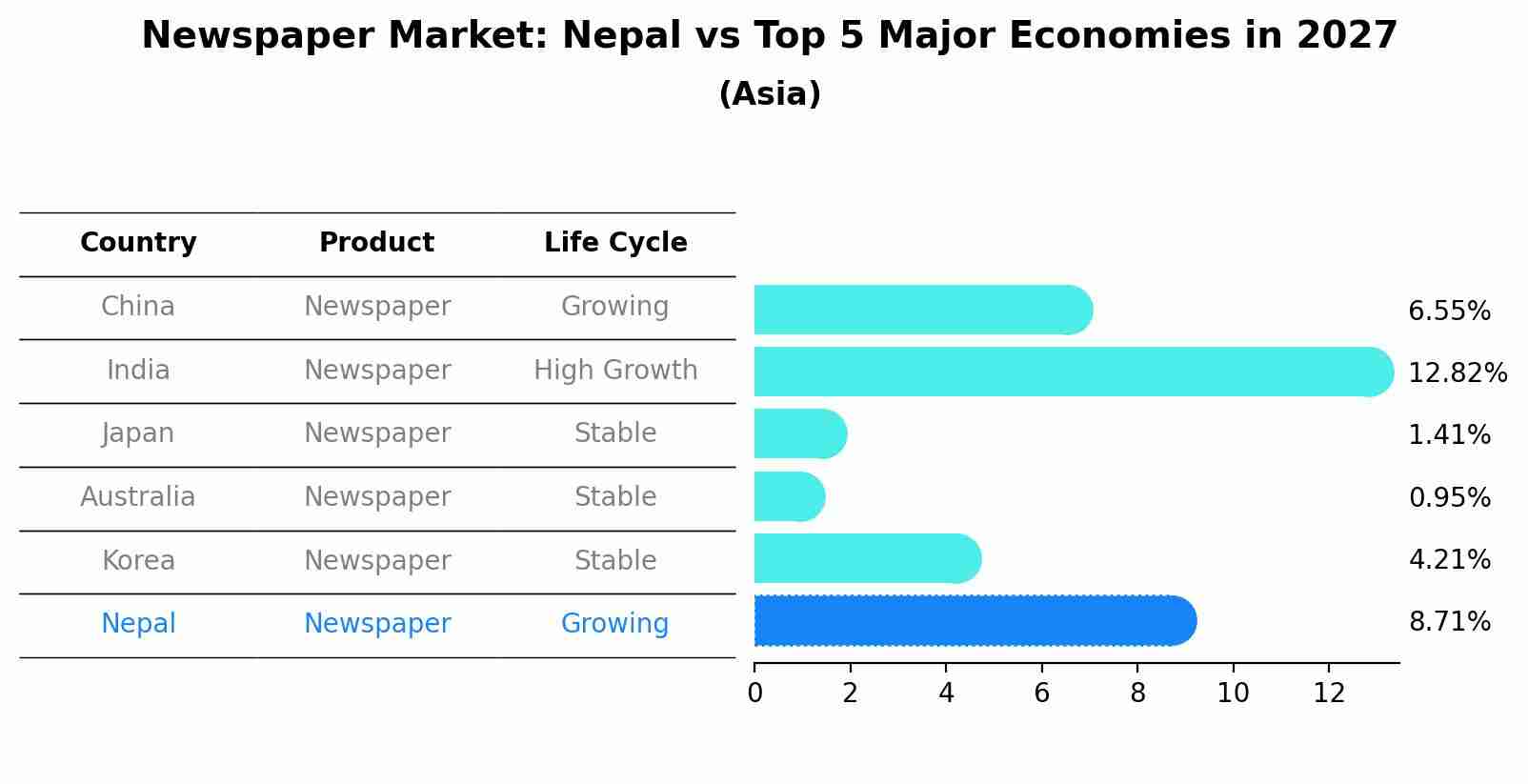Nepal Newspaper Market (2025-2031) | Analysis, Industry, Forecast, Revenue, Trends, Outlook, Value, Size, Growth, Share & Companies
| Product Code: ETC041657 | Publication Date: Jan 2021 | Updated Date: Jun 2025 | Product Type: Report | |
| Publisher: 6Wresearch | Author: Bhawna Singh | No. of Pages: 70 | No. of Figures: 35 | No. of Tables: 5 |
Nepal Newspaper Market Size Growth Rate
The Nepal Newspaper Market is poised for steady growth rate improvements from 2025 to 2029. Commencing at 6.61% in 2025, growth builds up to 10.61% by 2029.

Newspaper Market: Nepal vs Top 5 Major Economies in 2027 (Asia)
In the Asia region, the Newspaper market in Nepal is projected to expand at a growing growth rate of 8.71% by 2027. The largest economy is China, followed by India, Japan, Australia and South Korea.

Nepal Newspaper Market Overview
The Nepal newspaper market is diverse, with a mix of both national and regional newspapers catering to a wide range of audiences. Major newspapers such as Kantipur, The Himalayan Times, and Annapurna Post have a significant readership and influence. The market is highly competitive, with newspapers constantly striving to provide quality content and stay relevant in the digital age. Print newspapers still hold a strong presence in Nepal, but online news portals are gaining popularity among the younger generation. The readership is primarily urban-centric, with a growing trend towards digital news consumption. Overall, the Nepal newspaper market reflects a dynamic and evolving media landscape, where traditional print media coexists with digital platforms to meet the information needs of the diverse population.
Nepal Newspaper Market Trends
The Nepal newspaper market is witnessing several key trends. Firstly, there is a growing shift towards digital platforms, with many newspapers expanding their online presence to cater to the increasing number of internet users in the country. Additionally, there is a rise in niche publications focusing on specific topics such as technology, lifestyle, and entertainment to target specific audiences. Another trend is the increased emphasis on multimedia content, with newspapers incorporating videos, podcasts, and interactive features to engage readers. Lastly, there is a growing awareness of sustainability and environmental issues, leading some newspapers to adopt eco-friendly practices in printing and distribution. Overall, the Nepal newspaper market is evolving to adapt to changing consumer preferences and technological advancements.
Nepal Newspaper Market Challenges
The Nepal newspaper market faces several challenges, including a decline in print circulation due to the rise of digital media platforms, limited advertising revenue, high production costs, and distribution challenges in remote areas. Additionally, the industry grapples with political pressure, censorship issues, and a lack of press freedom, which can hinder journalistic integrity and editorial independence. Competition from international news sources and social media platforms also pose a threat to traditional newspapers in Nepal. Adapting to changing reader preferences, embracing digital transformation, and ensuring sustainable business models are crucial for newspapers in Nepal to stay relevant and competitive in the evolving media landscape.
Nepal Newspaper Market Investment Opportunities
The Nepal newspaper market offers various investment opportunities for both domestic and international investors. With a growing literacy rate and an increasing interest in news consumption, there is a demand for quality journalism and diverse content. Investing in established newspaper companies can provide a stable source of revenue through advertising sales and subscriptions. Furthermore, there is potential for growth in digital media platforms as more Nepali consumers turn to online news sources. Investing in technology and infrastructure to support digital news delivery can be a lucrative opportunity in the evolving newspaper market of Nepal. Additionally, collaborations with local content creators and journalists can help in creating unique and engaging content that resonates with the Nepali audience, thus attracting more readers and advertisers.
Nepal Newspaper Market Government Policy
In Nepal, the newspaper market is governed by the Press Council Act which mandates the registration of newspapers and the Press Council to oversee ethical standards. The government also imposes restrictions on content that is deemed to threaten national security or public order. Additionally, there are regulations concerning foreign investment in the media sector, with limits on ownership and control by non-Nepali citizens. The government provides some support to the newspaper industry through advertising revenue, but there are concerns about political influence and interference in editorial independence. Overall, government policies in Nepal aim to regulate the newspaper market to ensure adherence to ethical standards and protect national interests, while also fostering a diverse and competitive media landscape.
Nepal Newspaper Market Future Outlook
The future outlook for the Nepal newspaper market presents a mix of challenges and opportunities. On one hand, the industry faces the ongoing trend of digitalization, with more readers turning to online news sources and social media platforms for information. This shift may lead to a decline in print circulation and advertising revenue for traditional newspapers. However, there are also opportunities for growth in the form of niche publications catering to specific audiences, as well as innovative digital strategies to engage readers and attract advertisers. The market is likely to see a consolidation of players as smaller publications struggle to compete with larger media conglomerates. Overall, the success of newspapers in Nepal will depend on their ability to adapt to changing consumer preferences and embrace digital transformation while maintaining the quality and credibility of their content.
Key Highlights of the Report:
- Nepal Newspaper Market Outlook
- Market Size of Nepal Newspaper Market, 2024
- Forecast of Nepal Newspaper Market, 2026
- Historical Data and Forecast of Nepal Newspaper Revenues & Volume for the Period 2021 - 2031
- Nepal Newspaper Market Trend Evolution
- Nepal Newspaper Market Drivers and Challenges
- Nepal Newspaper Price Trends
- Nepal Newspaper Porter's Five Forces
- Nepal Newspaper Industry Life Cycle
- Historical Data and Forecast of Nepal Newspaper Market Revenues & Volume By Platform for the Period 2021 - 2031
- Historical Data and Forecast of Nepal Newspaper Market Revenues & Volume By Print for the Period 2021 - 2031
- Historical Data and Forecast of Nepal Newspaper Market Revenues & Volume By Digital for the Period 2021 - 2031
- Historical Data and Forecast of Nepal Newspaper Market Revenues & Volume By Business Model for the Period 2021 - 2031
- Historical Data and Forecast of Nepal Newspaper Market Revenues & Volume By Subscription for the Period 2021 - 2031
- Historical Data and Forecast of Nepal Newspaper Market Revenues & Volume By Advertising for the Period 2021 - 2031
- Nepal Newspaper Import Export Trade Statistics
- Market Opportunity Assessment By Platform
- Market Opportunity Assessment By Business Model
- Nepal Newspaper Top Companies Market Share
- Nepal Newspaper Competitive Benchmarking By Technical and Operational Parameters
- Nepal Newspaper Company Profiles
- Nepal Newspaper Key Strategic Recommendations
Frequently Asked Questions About the Market Study (FAQs):
1 Executive Summary |
2 Introduction |
2.1 Key Highlights of the Report |
2.2 Report Description |
2.3 Market Scope & Segmentation |
2.4 Research Methodology |
2.5 Assumptions |
3 Nepal Newspaper Market Overview |
3.1 Nepal Country Macro Economic Indicators |
3.2 Nepal Newspaper Market Revenues & Volume, 2019 & 2026F |
3.3 Nepal Newspaper Market - Industry Life Cycle |
3.4 Nepal Newspaper Market - Porter's Five Forces |
3.5 Nepal Newspaper Market Revenues & Volume Share, By Platform, 2019 & 2026F |
3.6 Nepal Newspaper Market Revenues & Volume Share, By Business Model, 2019 & 2026F |
4 Nepal Newspaper Market Dynamics |
4.1 Impact Analysis |
4.2 Market Drivers |
4.3 Market Restraints |
5 Nepal Newspaper Market Trends |
6 Nepal Newspaper Market, By Types |
6.1 Nepal Newspaper Market, By Platform |
6.1.1 Overview and Analysis |
6.1.2 Nepal Newspaper Market Revenues & Volume, By Platform, 2016 - 2026F |
6.1.3 Nepal Newspaper Market Revenues & Volume, By Print, 2016 - 2026F |
6.1.4 Nepal Newspaper Market Revenues & Volume, By Digital, 2016 - 2026F |
6.2 Nepal Newspaper Market, By Business Model |
6.2.1 Overview and Analysis |
6.2.2 Nepal Newspaper Market Revenues & Volume, By Subscription, 2016 - 2026F |
6.2.3 Nepal Newspaper Market Revenues & Volume, By Advertising, 2016 - 2026F |
7 Nepal Newspaper Market Import-Export Trade Statistics |
7.1 Nepal Newspaper Market Export to Major Countries |
7.2 Nepal Newspaper Market Imports from Major Countries |
8 Nepal Newspaper Market Key Performance Indicators |
9 Nepal Newspaper Market - Opportunity Assessment |
9.1 Nepal Newspaper Market Opportunity Assessment, By Platform, 2019 & 2026F |
9.2 Nepal Newspaper Market Opportunity Assessment, By Business Model, 2019 & 2026F |
10 Nepal Newspaper Market - Competitive Landscape |
10.1 Nepal Newspaper Market Revenue Share, By Companies, 2024 |
10.2 Nepal Newspaper Market Competitive Benchmarking, By Operating and Technical Parameters |
11 Company Profiles |
12 Recommendations |
13 Disclaimer |
- Single User License$ 1,995
- Department License$ 2,400
- Site License$ 3,120
- Global License$ 3,795
Search
Thought Leadership and Analyst Meet
Our Clients
Related Reports
- Afghanistan Apparel Market (2026-2032) | Growth, Outlook, Industry, Segmentation, Forecast, Size, Companies, Trends, Value, Share, Analysis & Revenue
- Canada Oil and Gas Market (2026-2032) | Share, Segmentation, Value, Industry, Trends, Forecast, Analysis, Size & Revenue, Growth, Competitive Landscape, Outlook, Companies
- Germany Breakfast Food Market (2026-2032) | Industry, Share, Growth, Size, Companies, Value, Analysis, Revenue, Trends, Forecast & Outlook
- Australia Briquette Market (2025-2031) | Growth, Size, Revenue, Forecast, Analysis, Trends, Value, Share, Industry & Companies
- Vietnam System Integrator Market (2025-2031) | Size, Companies, Analysis, Industry, Value, Forecast, Growth, Trends, Revenue & Share
- ASEAN and Thailand Brain Health Supplements Market (2025-2031) | Strategy, Consumer Insights, Analysis, Investment Trends, Opportunities, Growth, Size, Share, Industry, Revenue, Segments, Value, Segmentation, Supply, Forecast, Restraints, Outlook, Competition, Drivers, Trends, Demand, Pricing Analysis, Competitive, Strategic Insights, Companies, Challenges
- ASEAN Bearings Market (2025-2031) | Strategy, Consumer Insights, Analysis, Investment Trends, Opportunities, Growth, Size, Share, Industry, Revenue, Segments, Value, Segmentation, Supply, Forecast, Restraints, Outlook, Competition, Drivers, Trends, Demand, Pricing Analysis, Competitive, Strategic Insights, Companies, Challenges
- Europe Flooring Market (2025-2031) | Outlook, Share, Industry, Trends, Forecast, Companies, Revenue, Size, Analysis, Growth & Value
- Saudi Arabia Manlift Market (2025-2031) | Outlook, Size, Growth, Trends, Companies, Industry, Revenue, Value, Share, Forecast & Analysis
- Uganda Excavator, Crane, and Wheel Loaders Market (2025-2031) | Strategy, Consumer Insights, Analysis, Investment Trends, Opportunities, Growth, Size, Share, Industry, Revenue, Segments, Value, Segmentation, Supply, Forecast, Restraints, Outlook, Competition, Drivers, Trends, Demand, Pricing Analysis, Competitive, Strategic Insights, Companies, Challenges
Industry Events and Analyst Meet
Whitepaper
- Middle East & Africa Commercial Security Market Click here to view more.
- Middle East & Africa Fire Safety Systems & Equipment Market Click here to view more.
- GCC Drone Market Click here to view more.
- Middle East Lighting Fixture Market Click here to view more.
- GCC Physical & Perimeter Security Market Click here to view more.
6WResearch In News
- Doha a strategic location for EV manufacturing hub: IPA Qatar
- Demand for luxury TVs surging in the GCC, says Samsung
- Empowering Growth: The Thriving Journey of Bangladesh’s Cable Industry
- Demand for luxury TVs surging in the GCC, says Samsung
- Video call with a traditional healer? Once unthinkable, it’s now common in South Africa
- Intelligent Buildings To Smooth GCC’s Path To Net Zero


















